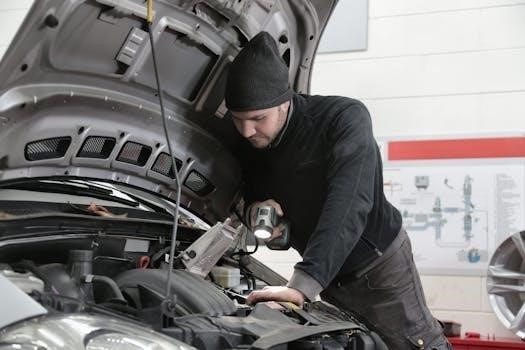This guide will help you navigate common issues with Club Car gas golf carts. Like other gas vehicles‚ they can face specific problems‚ such as starting issues or loss of power. This resource will provide you with key troubleshooting steps to ensure your cart operates smoothly.
Common Issues with Gas Golf Carts
Gas golf carts‚ including Club Car models‚ often encounter problems related to their fuel and electrical systems. Common issues include a failure to start‚ which can stem from a lack of fuel‚ a fouled spark plug‚ or a problem with the choke mechanism. Additionally‚ loose belts within the motor can prevent the cart from moving. Other frequent problems are fuse and key switch malfunctions‚ as well as wiring issues‚ such as loose connections or wear and tear on wires. Intermittent starting problems or loss of power can also occur‚ sometimes due to a faulty fuel pump or carburetor. Addressing these issues promptly is key to maintaining the performance of your cart.

Initial Troubleshooting Steps
Begin by checking the fuel system for clogs and ensure the tank is full. Next‚ inspect the spark plug for dirt or wear. These initial checks can help identify common issues.
Checking the Fuel System
When troubleshooting a Club Car gas golf cart‚ start by thoroughly checking the fuel system. First‚ confirm that there is adequate fuel in the tank. Next‚ examine the fuel lines for any clogs or blockages that may restrict fuel flow. Pay close attention to the fuel filter‚ which can become clogged over time‚ preventing fuel from reaching the carburetor. Additionally‚ inspect the fuel pump to ensure it is operating correctly and delivering fuel to the engine. If you suspect a fuel-related problem‚ these checks are the best place to begin. Addressing these areas will resolve common starting and running issues.
Inspecting the Spark Plug
Another critical step in troubleshooting a gas Club Car golf cart involves inspecting the spark plug. Remove the spark plug and carefully examine its condition. A fouled or worn spark plug can prevent the engine from starting or running smoothly. Look for signs of carbon buildup‚ oil fouling‚ or damage to the electrode. If the spark plug appears dirty‚ clean it thoroughly or replace it with a new one. Ensure that the spark plug gap is set to the manufacturer’s specifications. This simple check can often resolve ignition problems‚ and is vital for proper engine function.

Engine Performance and Starting Problems
Many Club Car gas golf cart issues involve engine performance or starting difficulties. This section addresses common problems such as the engine cranking but failing to start‚ and issues with loose belts.
Engine Cranks but Won’t Start
If your Club Car gas golf cart’s engine cranks but doesn’t start‚ several factors could be at play. Begin by ensuring there’s sufficient fuel in the tank. Then‚ inspect the spark plug; it may be fouled or worn and need cleaning or replacement. Verify that the choke is properly engaged‚ as it is essential for cold starts. Additionally‚ check the fuel lines for any clogs that could prevent fuel from reaching the carburetor. These steps are vital in diagnosing why the engine refuses to ignite‚ despite turning over.
Addressing Loose Belts
A common issue that can cause a Club Car gas golf cart to not move is loose or damaged belts within the motor. When troubleshooting‚ begin by inspecting these belts carefully for any signs of fraying or other damage. If a belt is damaged‚ you will need to loosen it using a wrench before removing it. Proper belt tension is essential for the cart’s propulsion system. Replacing worn belts will ensure efficient power transfer from the engine. Checking and maintaining the belts will help prevent future issues.

Electrical System Troubleshooting
When troubleshooting electrical problems‚ start by checking battery connections for corrosion or looseness. Inspect wiring for wear or disconnections‚ and test the solenoid to ensure proper function.
Checking Battery Connections and Wiring
Begin your electrical system check by examining the battery terminals for any signs of corrosion‚ which can disrupt the flow of electricity. Ensure that all connections are tight and secure‚ as loose terminals can cause intermittent power issues. Carefully inspect the wiring throughout the cart‚ looking for any wear‚ fraying‚ or disconnections. Pay close attention to the wires connected to the controller‚ as these are crucial for proper operation. Addressing any wiring issues promptly can prevent further complications and restore the functionality of your Club Car golf cart. Remember to disconnect the battery before handling any electrical components for safety.
Testing the Solenoid
The solenoid is a crucial component in the electrical system of your Club Car‚ acting as a switch for the starter motor. To test it‚ first‚ ensure the golf cart’s key switch is in the ‘on’ position. Use a multimeter to check for voltage at the small terminals of the solenoid when the accelerator is depressed. If voltage is present‚ but the starter doesn’t engage‚ the solenoid may be faulty. You can also test the continuity across the large terminals when the solenoid is activated; a lack of continuity suggests a need for replacement. Verify all connections are secure before proceeding with a replacement.
Advanced Troubleshooting
For complex issues beyond basic checks‚ advanced troubleshooting may be required. This involves testing motor continuity and inspecting carburetor and fuel pump functionality to pinpoint the problem.
Motor Continuity Test
To perform a motor continuity test‚ first‚ disconnect all wires from the motor‚ carefully labeling each one for reconnection. Ensure that none of the terminals are grounded to the motor or cart frame. Use a multimeter to check for continuity between specific terminals. You should find continuity between F1 and F2‚ and between A1 and A2‚ but there should be no continuity between any A and any F terminal. This test helps identify internal motor issues‚ where a lack of continuity between these points suggests a fault. Following these steps‚ you can effectively troubleshoot potential motor problems.
Carburetor and Fuel Pump Issues
Carburetor and fuel pump problems are common causes of starting or running issues in gas golf carts. A dirty carburetor can prevent proper fuel delivery‚ leading to stalling or poor performance. Similarly‚ a faulty fuel pump might not deliver enough fuel to the carburetor. Check for fuel flow by disconnecting the line at the carb and checking for fuel output. If the pump seems weak‚ it may need replacement. Cleaning the carburetor and ensuring proper fuel flow is crucial. It’s also important to inspect for any air leaks in the fuel system. This will contribute to optimal engine performance.
Maintenance and Prevention
Regular maintenance is crucial for preventing issues. Simple checks‚ like air filter cleaning and belt inspections‚ can extend the life of your golf cart and ensure optimal performance.
Importance of Air Filter Maintenance
Maintaining a clean air filter is vital for your Club Car gas golf cart’s engine performance. A clogged or dirty filter restricts airflow‚ leading to reduced engine efficiency and power. This can cause the engine to work harder‚ consuming more fuel and potentially causing damage over time. Regular inspection and cleaning of the air filter ensure that the engine receives adequate airflow for the combustion process‚ promoting optimal performance and extending the life of the engine. Replacement may be necessary if the filter appears damaged or excessively dirty. Proper air filter maintenance is a key element in preventing engine-related problems and ensuring the longevity of your golf cart.
General Maintenance Tips
Regular maintenance is crucial for the longevity and optimal performance of your Club Car gas golf cart. Check the fuel levels and ensure there are no clogs in the fuel lines. Inspect the spark plug regularly‚ cleaning or replacing it if needed. Keep the battery terminals clean and free of corrosion. Ensure all wiring is secure and without any signs of damage. Examine the belts for fraying or wear. Cleaning the golf cart battery cables and terminals can prevent power disruption. Periodically check the air filter‚ replacing if needed. These general maintenance practices will help prevent problems and ensure that your golf cart runs smoothly and efficiently.

When to Seek Professional Help
If troubleshooting steps don’t resolve the issues‚ or you suspect complex problems with the carburetor‚ fuel pump‚ or ignition system‚ consult a qualified mechanic for assistance.
Consulting a Professional Mechanic
When your Club Car gas golf cart exhibits issues beyond basic troubleshooting‚ seeking a professional mechanic is advisable. Mechanics possess specialized tools and knowledge to diagnose complex problems such as carburetor malfunctions‚ internal engine issues‚ or intricate electrical system failures. They can accurately assess the root cause of the problem and implement effective repairs. Furthermore‚ attempting to fix complex issues without proper training can potentially cause further damage‚ leading to more costly repairs down the line. By consulting a professional‚ you ensure the job is done correctly and your golf cart will get back to peak performance.
Identifying Complex Problems
Recognizing when a Club Car gas golf cart issue requires professional attention is crucial. If basic troubleshooting steps like checking fuel‚ spark‚ and belts fail to resolve the problem‚ it may point to a complex issue. Problems like intermittent starting‚ persistent engine sputtering‚ or recurring electrical faults often signal deeper issues. These could include faulty controllers‚ damaged motor components‚ or intricate fuel system problems beyond simple cleaning or replacement. Identifying complex problems early on can prevent further damage and ensure that a qualified mechanic can address the underlying issue effectively.